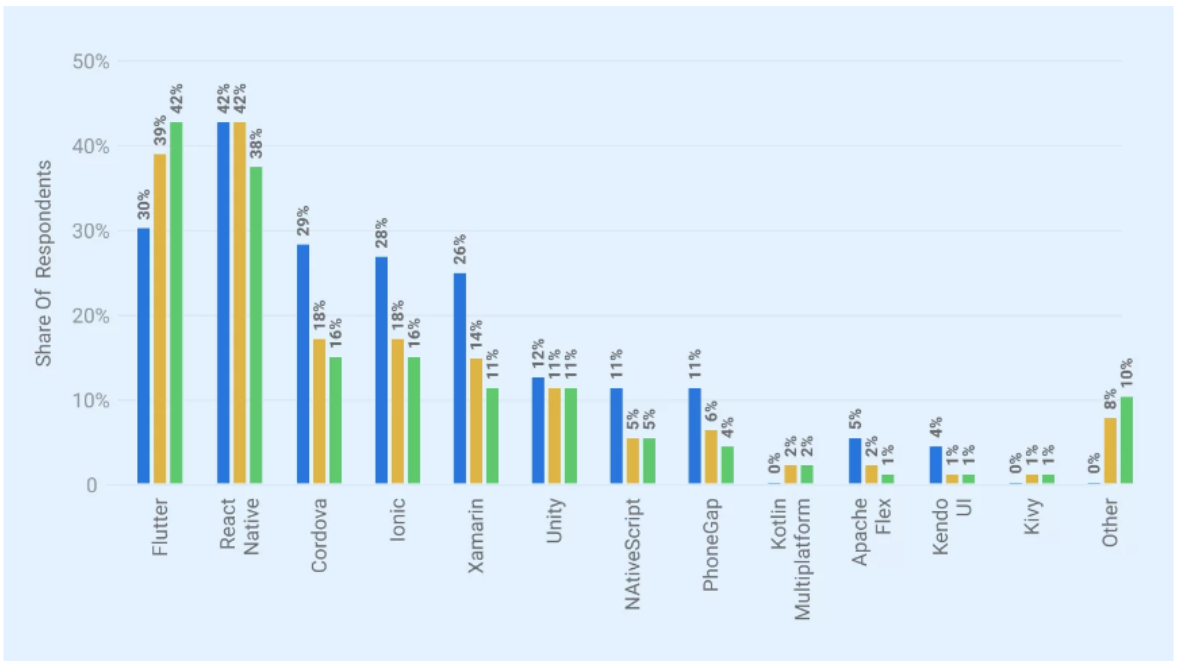
Cross Platform App Development: Top Frameworks for 2024
Introduction
Cross platform mobile app development is undeniably shaping the future of app creation. Yet, amidst the myriad of frameworks available, decision-makers frequently encounter the challenge of selecting the most suitable technology. Fortunately, by aligning project requirements with preferences, comparing and selecting the optimal framework becomes more streamlined and accessible.
This blog aims to help decision-makers discover the top nine frameworks for cross-platform app development that will dominate the industry in 2024 and beyond. Moreover, it provides insights into how to select the ideal cross platform mobile app development framework for business.
So, let’s get started!
Table of Contents
3.1. Flutter
3.2. Xamarin
3.3. React Native
3.4. Ionic
3.5. PhoneGap
3.6. Sencha Touch
3.7. Unity
3.8. Node.js
Cross Platform App Development: Why it matters for businesses in the first place?
Cross-platform app development is essential for businesses looking to maximize reach and stay ahead in today’s competitive landscape. Creating apps that work on multiple platforms and provide a consistent user experience can save businesses time and resources and increase customer satisfaction and thus, business revenue.
Cross-platform mobile app development also helps businesses stay agile and adaptable to changing market demands. Leveraging the latest technologies is crucial for business owners, and cross-platform development is a key component of this strategy.
Before we explore the top frameworks for 2024, let’s first understand what cross-platform mobile app development frameworks entail.
Don’t let platform-specific development hold you back!
Discover how cross-platform app development can revolutionize your business
What are cross platform app development frameworks?
Cross-platform app development frameworks enable developers to create mobile applications that can run on multiple operating systems, such as iOS and Android. These frameworks allow developers to write code once and deploy it across different platforms, which makes the app development process more efficient and cost-effective.
According to the persistence market research report, the global demand for cross-platform app development frameworks is expected to rise 16.8% over the next ten years. By 2033, the total market size will reach US$546.7 billion.
Various Cross Platform App Development Frameworks

Top 9 Cross Platform App Development Frameworks in 2024
Understanding the frameworks dominating the marketplace is essential to developing a successful cross platform mobile app in 2024.
Below are the nine best cross-platform mobile app development frameworks for 2024, ranked by their strengths, limitations, and apps built on each.
Flutter
Flutter, Google’s idea, brings a gamut of benefits in cross platform mobile app development for business owners looking for practical and elegant applications.
Benefits:
- Hot Reload for Real-Time Changes: Flutter’s hot reload feature significantly enhances development efficiency by allowing developers to immediately see the effects of code changes, facilitating faster iterations and debugging.
- Single Codebase for iOS and Android: With Flutter, developers can write code once and use it on both iOS and Android platforms, thus saving time and resources while ensuring consistent app behaviour and performance.
- Rich Collection of Widgets: Flutter offers a comprehensive set of customizable widgets, enabling developers to create expressive and visually appealing user interfaces tailored to their app’s requirements.
Limitations
- Some advanced features may require additional effort for implementation.
- It may not be the best choice for apps requiring extensive graphics processing.
Popular Apps Built on Flutter:
- Google Ads
- KlasterMe
- Reflectly
- Cryptograph
Xamarin
Xamarin is a popular cross-platform app development framework that allows developers to build native mobile apps for iOS, Android, and Windows devices integrating C# and .NET. It uses a shared codebase approach and provides various tools and features to make cross-platform app development faster and more efficient, including Xamarin.Forms for building native UIs using a single, shared codebase.
Benefits:
- Native-Like Performance: Xamarin ensures high performance and seamless user experience by leveraging C# codebase, providing access to native APIs, and optimizing app performance across different platforms.
- Seamless Microsoft Integration: Developers benefit from seamless integration with Microsoft services such as Azure, enabling easy access to cloud services, analytics, and other essential tools for app development and management.
- Familiar Language for Developers: With Xamarin, developers can use C#, a widely adopted language, reducing the learning curve and accelerating the development process, especially for teams already familiar with Microsoft technologies.
Limitations
- Access to specific libraries and features may require additional investment.
- Apps built with Xamarin may have larger file sizes than other frameworks.
Popular Apps Built on Xamarin:
- Storyo
- PictureX
- The World Bank
- Captio
React Native
Developed by Facebook, React Native is one of the most widely adopted cross-platform frameworks. It enables developers to build natively rendered mobile applications for iOS and Android platforms, offering a seamless user experience with its component-based architecture.
Benefits:
- Efficient Reusable Components: React Native’s component-based architecture allows developers to create reusable UI components, streamlining development and ensuring consistency across different app sections.
- Strong Community Support: With a vast and active community, React Native provides extensive documentation, resources, and libraries, empowering developers to solve challenges, share knowledge, and accelerate development.
- Native-Like Feel with JavaScript: React Native delivers a smooth and responsive user experience by leveraging JavaScript, ensuring optimal performance and compatibility across iOS and Android platforms.
Limitations
- Optimizing performance for complex applications can be challenging.
- Integrating complex features may introduce dependencies requiring careful management.
Popular Apps Built on React Native:
- Airbnb
- Discord
Ionic
Ionic is an open-source SDK for cross-platform development of mobile apps using web technologies, including HTML, CSS, and JavaScript. It offers a simple, developer-friendly framework for creating native-like mobile apps, integrating with Angular for structure and Cordova for accessing device features.
Benefits:
- Easy Learning Curve for Rapid Development: Ionic’s developer-friendly framework and pre-built UI components facilitate rapid prototyping and iteration, making it ideal for startups and businesses looking to quickly bring their app notions to life.
- Seamless Angular Integration: Integration with Angular enhances Ionic’s functionality, providing developers with a robust framework for quickly building feature-rich, interactive applications.
- Cross-Platform Compatibility: Ionic helps developers build apps that seamlessly run on multiple platforms using standard web technologies like HTML, CSS, and JavaScript, ensuring broad reach and accessibility.
Limitations
- Not suitable for high-performance applications with intensive processing requirements.
- Implementing complex features may require additional effort and expertise.
Popular Apps Built on Ionic:
- Untappd
- Sworkit
- Nationwide
- MarketWatch
PhoneGap
PhoneGap, or Apache Cordova, is popular for cross-platform app development. It aids developers in building mobile apps by applying web technologies such as JavaScript, HTML, and CSS and deploying them across multiple platforms with minimal code modifications.
Benefits:
- Rapid Development: PhoneGap accelerates the development process through its extensive plugin ecosystem and streamlined workflow, enabling developers to build and deploy cross-platform apps quickly and efficiently.
- Cross-Platform Compatibility: PhoneGap reduces development time and effort by enabling code reuse across different platforms, allowing businesses to surpass a broader audience with minimal additional investment.
- Access to Native Features: PhoneGap provides native device features through plugins, allowing developers to leverage device capabilities such as GPS and camera and push notifications in their apps, enhancing user experience and functionality.
Limitations
- PhoneGap apps may not match the performance of fully native applications.
- Applying advanced native features may be challenging or require custom development.
Popular Apps Built on PhoneGap:
- Wikipedia
- TripCase
- Untappd
- Buildr
Sencha Touch
Sencha Touch is a framework for developing cross-platform mobile web applications with HTML5, CSS3, and JavaScript. It renders a comprehensive set of UI components and tools for building interactive and visually appealing mobile apps.
Benefits:
- Rich User Interface Design: Sencha Touch offers a comprehensive set of pre-designed UI components and themes, enabling developers to create professional-looking mobile apps with minimal effort.
- High Performance and Responsive Design: Sencha Touch’s optimized animations and responsive layouts ensure a smooth, in-line user experience over various devices and screen sizes.
- Comprehensive Documentation and Support: Sencha Touch provides extensive documentation, resources, and a supportive community, empowering developers to overcome challenges and maximize the framework’s potential.
Limitations
- Developers may require time to familiarize themselves with the architecture and conventions of Sencha Touch.
- Dependency on Sencha Cmd for building and packaging applications may introduce additional complexity.
Popular Apps Built on Sencha Touch:
- Extensity
- Analytics App
- SAP Hybris
- MHS Assessment
Unity
Unity is a powerful game development platform that also supports cross-platform app development. It allows developers to create interactive 2D and 3D applications for mobile, desktop, web, and VR/AR platforms.
Benefits:
- Cross-Platform Support: Unity’s robust game development platform extends to cross-platform app development, enabling developers to create interactive 2D and 3D applications for mobile, desktop, web, and VR/AR platforms.
- High-Performance Graphics: With advanced graphics capabilities, Unity allows developers to build visually stunning and immersive experiences, making it suitable for various applications, including games, simulations, and interactive experiences.
- Vibrant Community: Unity boasts a large and active developer community that provides valuable resources, tutorials, and support, empowering developers to unleash their creativity and build innovative applications.
Limitations
- Unity has a significant learning curve, particularly for developers new to game development or 3D graphics programming.
- Deploying Unity applications across different platforms may require platform-specific optimizations and adjustments for optimal performance and compatibility.
Popular Apps Built on Unity:
- Pokémon Go
- Angry Birds 2
- Monument Valley
- Temple Run 2
Node.js
Node.js is a cross-platform framework for building scalable and high-performance applications using JavaScript as its primary language. Its package manager, NPM, provides a vast library of modules and packages, and its non-blocking I/O model makes it efficient and scalable.
Benefits:
- Non-Blocking I/O: Node.js’ non-blocking I/O model enables it to handle multiple requests simultaneously and efficiently, resulting in high performance and low latency, making it perfect for real-time applications and services.
- Event-Driven Architecture: With an event-driven architecture, Node.js can respond to user requests and events in real time, making it well-suited for building responsive and interactive applications such as chat apps, gaming platforms, and streaming services.
- Open-Source Community: Node.js benefits from a substantial and active open-source community that adds to its development and provides support through forums, documentation, and tutorials, ensuring its continuous improvement and evolution.
Limitations
- Node.js can only use one CPU core at a time, which can be a bottleneck for CPU-intensive applications.
- This framework uses callbacks to handle asynchronous operations, which can lead to complex code and challenging error handling.
Popular Apps Built on Node.js:
- FanReact
- Noodlio Pay
- Snippit
- ThunderPenn
Appcelerator Titanium
Appcelerator Titanium is a cross-platform mobile development framework that allows developers to develop native mobile applications utilizing web technologies like HTML, CSS, and JavaScript.
Benefits:
- Native Performance: Appcelerator Titanium leverages native UI components and direct API access, providing high-performance and native-like user experiences across multiple platforms.
- Code Reusability: Titanium enables code reusability across platforms, decreasing development time and effort while ensuring consistency and compatibility with various devices and OSs
- Community Support: With an active community of developers, Appcelerator Titanium offers valuable resources, tutorials, and support, empowering developers to overcome challenges and maximize their productivity with the framework.
Limitations
- Titanium may need help with plugin compatibility and community support compared to other frameworks.
- Learning Appcelerator Titanium may require time and effort, particularly for developers new to its architecture and conventions.
Popular Apps Built on Appcelerator Titanium:
- OREO
- Land Rover InControl
- Belly
- SBB Mobile
Top 9 Cross Platform App Development Frameworks Comparison
| Framework | Language/ Technology | Key Features | Integration | Performance |
|---|---|---|---|---|
| Flutter | Dart | Hot Reload Expressive UI | Smooth integration with different IDEs | Excellent |
| Xamarin | C# | Native Like Performance Microsoft Integration | Seamless integration with Microsoft services | Excellent |
| React Native | JavaScript/ React | Reusable Components. Community support | Extensive library, easy integration with React | Excellent |
| Ionic | Angular, Cordova | Pre-built UI Components, Angular Integration | Integrates well with Angular, Cordova compatibility | Moderate |
| PhoneGap | HTML, JavaScript, CSS | Quick Prototyping, Adobe Service | Seamless integration with Adobe services | Moderate |
| Sencha Touch | JavaScript | Rich User Interface Design | Comprehensive documentation, Rich UI components | Good |
| Unity | C# | 3D Graphics Capabilities | Adaptable integration with other frameworks | Excellent |
| Node.js | JavaScript | Event-driven, non-blocking I/O model | Excellent | |
| Appcelerator Titanium | JavaScript/TypeScript | Native UI components, Direct API Access | Integrates well with JavaScript/Type Script | Good |
How to choose the best Cross Platform App Development Framework?
Before selecting a cross-platform app development framework, analyze your project’s performance and native feature requirements. Then, research options like Flutter, Xamarin, React Native, Ionic, and PhoneGap, considering factors like development experience, community support, performance, and budget considerations.
Remember, there is no one-size-fits-all framework; choose what works best for your needs.
Final Thoughts
As you navigate the dynamic landscape of cross-platform app development, remember that your framework choice isn’t just a decision – it’s a declaration of intent. It’s more than lines of code; it’s about crafting experiences that resonate. Take the time to understand your project’s needs, explore options, and envision the future you want to create. With the right framework, you’re not just building an app but shaping the future.
So, dare to dream big, choose boldly, and let your imagination soar.
Always rely on a trusted mobile app development company for guidance and support. They can help you make the correct decision and successfully head out for your cross-platform app development journey.
Take app development to the next level with the best
Cross platform app development frameworks
FAQs for Cross Platform App Development Frameworks
What is cross-platform app development?
Cross-platform app development enables developers to build mobile applications for multiple OSs, such as iOS and Android, using a single codebase. This approach saves time and resources, making it an efficient business solution.
Can cross-platform apps access native device features?
Yes. Cross-platform apps can access native device features like cameras, GPS, accelerometers, and push notifications using plugins or APIs provided by the frameworks.
How does cross-platform app performance compare to native apps?
Although cross-platform apps can come close to native performance, they may not always match fully native apps, especially for graphics or CPU-heavy tasks. However, advancements in cross-platform frameworks have significantly narrowed the performance gap.
Are there any limitations to cross-platform mobile app development?
Some limitations include potential performance differences compared to native apps, limitations in accessing certain platform-specific features, and occasional challenges with maintaining consistent UI across different platforms. However, framework improvements are continually addressing and mitigating these limitations.
Share this post
About the Author

Sujoy Roy
(Head – Digital Marketing)
From my teenage time, I had a quench to solve problems and loved leadership. Starting my career in relation management, ignited my passion for managing people. While managing I realized technology needs to be incorporated to keep pace with the changing world & do my work efficiently.

